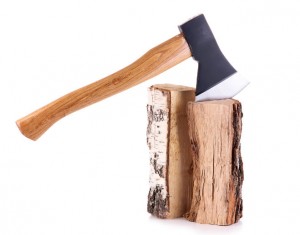Nothing is quite as soothing during those increasingly cold winter months as a crackling fire in your fireplace. That starts with a nice stack of well-seasoned firewood. Don’t fret—it’s not too late to replenish your stores to make sure you’re ready when the cold starts creeping in.
You’ll want to choose your wood wisely…

Based in Selkirk, NY, our team of skilled and knowledgeable chimney technicians has been working to keep the hearths and homes of upstate New York warm and cozy for over 35 years. Having worked with just about every type and style of heating appliance, our technicians know which products are the best, and which ones aren’t worth the investment.
Well-seasoned firewood (typically wood that was cut at least 6-8 months ago) will help your fireplace burn cleaner and more efficiently. Split wood also dries faster because more of the wood’s surface area is exposed to air. Freshly cut wood can contain up to 50% water, whereas seasoned firewood checks in at about 25%. Unseasoned firewood (also known as green or wet wood) can cause excessive smoke, creosote buildup and the potential for chimney fires.
You’ll want to make sure you have enough wood…
This is an area in which many people struggle. How much wood is enough? It really depends on how often you plan to build a fire. As a general rule of thumb, however, anywhere from 1-2 cords of wood should be sufficient enough to get you through the winter (a cord is 128 ft³, which equates to a stack that is 8 feet long, 4 feet high and 4 feet deep).
You’ll want to burn hardwoods…
Hardwoods (alder, hickory and maple are common examples) will cost you more; however, because they’ll burn longer and put off more heat, they’ll save you money in the long run). In addition to the cost savings, you’ll find yourself having to add wood to the fire less frequently, which will free up time for other, more desirable activities. Softwoods (pine is a prime example), on the other hand, burn much faster and often crack and pop too much while burning.
You’ll want to avoid burning scrap materials…
Burning construction scraps is not advisable. Salvaged wood from decking and landscaping ties can contain dangerous chemicals (arsenic is a common wood preservative) that could harm you and everyone in your home; painted, stained and all pressure-treated woods are a huge no-no as well.
You’ll want to store your wood off of the ground…
When storing your wood, keep it stacked a minimum of 3 inches off of the ground, preferably in a dry or semi-dry area. The ideal place to store your wood would be in a wood storage shed, at least 15 feet from the house.
You’ll want to cover your wood up…
If your wood is left uncovered while seasoning, it can easily reabsorb large amounts of water, which would make it difficult to burn and could cause it to rot (making it unusable altogether). Once your wood is stacked, cover it with a plastic tarp that’s either weighted or tied down to prevent moisture from seeping in.
You’ll want to store your wood wisely…
It’s recommended that you not store more than a week’s worth of wood close to your house, as big piles of wood are known to attract unwanted guests (termites). Rotten wood and evidence of mud tubes in the logs are sure signs that you may have an infestation on your hands. Large amounts of wood can also harbor mold spores, which could then be brought into your home, thereby affecting your indoor air quality.
You’ll want to use a little forethought…
Don’t keep a lot of wood stacked up inside your house. Plan to bring in only what you need about a day before you plan to use it to give it adequate time to dry out and ready itself for burning.
These easy-to-follow steps will have you ready to get that fireplace going when winter arrives. At Northeastern Fireplace & Design, it is our mission to provide our customers with not only a service, but an experience. We want to leave an impression on you by offering services and workmanship that our competitors cannot match. We invite you to discover this for yourself. Give us a call or stop by our showroom to learn more!
